9.4 /10 1 Votes
Publisher(s) Nintendo Producer(s) Shigeru Miyamoto Mode(s) Single-player Composer Koji Kondo | 4.7/5 Emuparadise Director(s) Kensuke Tanabe Genre(s) Platforming Initial release date 1988 Series Mario Series | |||||||||||||||||||||||||||||||||
 | ||||||||||||||||||||||||||||||||||
Platforms Nintendo Entertainment System, Wii, Nintendo 3DS Developers Nintendo, Nintendo Entertainment Analysis & Development Designers Shigeru Miyamoto, Koji Kondo Similar Mario Series games, Nintendo games, Platform games | ||||||||||||||||||||||||||||||||||
Super mario bros 2 video walkthrough
Super Mario Bros. 2, released in Japan as Super Mario USA (Japanese: スーパーマリオUSA, Sūpā Mario USA), is a platform game developed and published by Nintendo for the Nintendo Entertainment System. The game was first released in North America in October 1988, and in PAL regions the following year. Super Mario Bros. 2 has been remade or re-released for several video game consoles.
Contents
- Super mario bros 2 video walkthrough
- Nintendo 3ds new super mario bros 2 e3 trailer
- Gameplay
- Plot
- Development
- Super Mario All Stars
- BS Super Mario USA Power Challenge
- Super Mario Advance
- Reception
- Legacy
- References
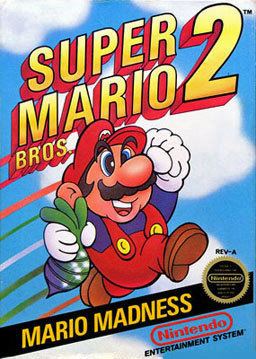
Development of Super Mario Bros. 2 started out as a prototype for a vertically scrolling, two-player, cooperative action game, but later was re-branded into Yume Kōjō: Doki Doki Panic, a Family Computer Disk System game meant to tie-in with Fuji Television's media technology expo, called Yume Kōjō (lit. Dream Factory). The characters, enemies, and themes of the game were meant to reflect the mascots and theme of the festival. After Nintendo of America found the Japanese Super Mario Bros. 2, later released internationally as Super Mario Bros.: The Lost Levels, to be too difficult and similar to its predecessor. Yume Kōjō: Doki Doki Panic was improved upon and converted back into Super Mario Bros. 2 for release outside of Japan.
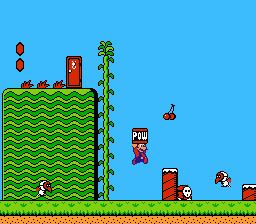
The game became a commercial success, and eventually, the game became well received enough that it was also released in Japan for the Family Computer itself as Super Mario USA. Since its successful sales yield, Super Mario Bros. 2 has been considered one of the best games in the series. It has since been re-released in the Super Mario All-Stars collection, as well as Super Mario Advance for the Game Boy Advance handheld system.
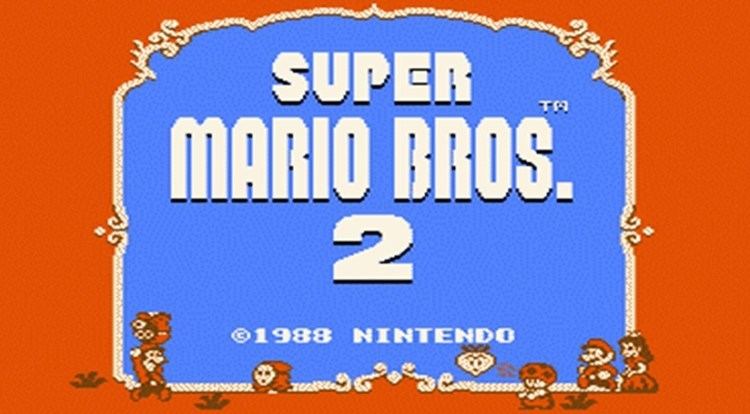
Nintendo 3ds new super mario bros 2 e3 trailer
Gameplay
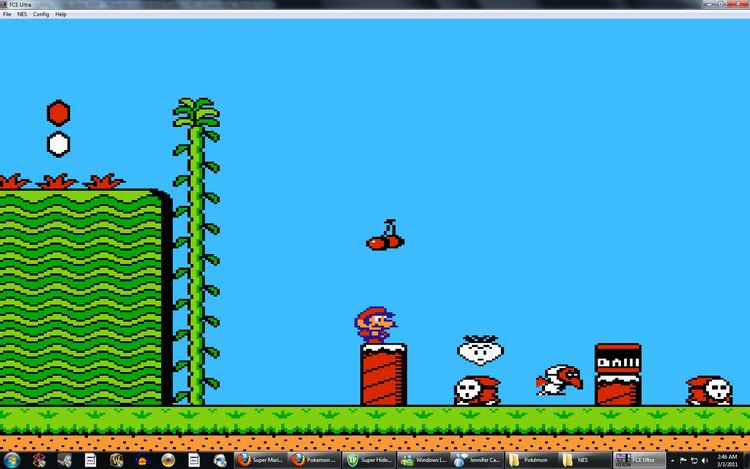
Super Mario Bros. 2 is a 2D side-scrolling platform game. The objective of the game is to navigate the player's character through the dream world Subcon and defeat the main antagonist Wart. Before each stage, the player chooses one of four different protagonists to use: Mario, Luigi, Toad, and Princess Peach. All four characters can run, jump, and climb ladders or vines, but each character possesses a unique strength that causes them to be controlled differently. For example, Luigi can jump the highest; Princess Peach can jump the farthest; Toad's strength allows him to pick up items quickly. As opposed to the original Super Mario Bros., which only moved from left to right, players can move either left or right, as well as vertically in waterfall, cloud and cave levels. Unlike other Mario games, the characters cannot defeat enemies by jumping on them; but they can stand on, ride on, and jump on the enemies. Instead, the character picks up and throws objects at the enemies, or throws the enemies away, to defeat them. These objects include vegetables plucked from the ground or other enemies.

The game consists of 20 different levels across the seven "worlds" comprising Subcon. Each world has a particular theme that dictates the obstacles and enemies encountered in its levels, such as desert areas with dangerous quicksand and snowy areas with slippery surfaces. Levels contain multiple sections or rooms that are connected via doors or ladders. Some rooms are accessible by entering certain jars. Magic potions found in each level are used to temporarily access "Sub-space", an inverted area where the player can collect coins and Mushrooms that increase the character's maximum health. In addition, certain jars, when entered in Sub-space, will warp the player to the later worlds, skipping levels altogether. Other items available include cherries, which are collected in order to acquire a Starman; and the POW block, which can be used to quickly destroy all the enemies visible on the screen.
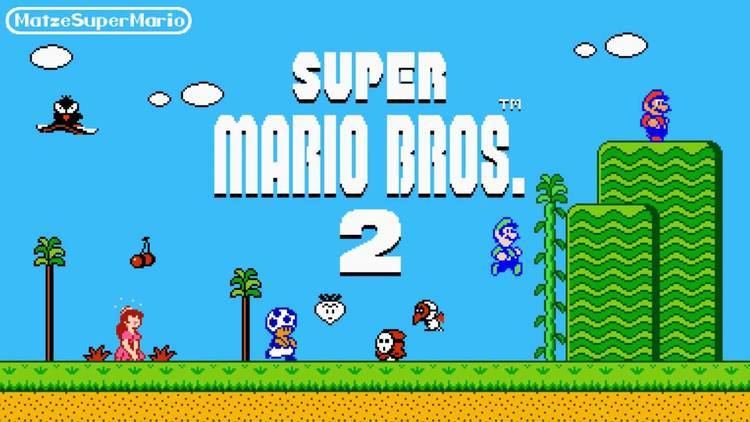
The player starts Super Mario Bros. 2 with three extra lives, which are lost each time the player's character loses all health from enemy or hazard damage or when the character falls off the screen. The player can replenish health by collecting floating hearts that appear upon defeating a certain number of enemies. The player will receive a Game Over upon losing the last life, though the player may continue up to twice in one game. Additional extra lives may be obtained by collecting hidden 1-Up Mushrooms or by using the coins collected from Sub-space to win the slot machine minigame played between the levels.
Plot
Mario has a dream of a staircase leading to a door to another world. A voice identifies the world as the dreamland of Subcon, and asks for Mario's help in defeating the villainous frog known as Wart, a tyrant who has cursed Subcon and its people. Mario suddenly awakes and decides to tell Luigi, Toad and Princess Peach, who all report experiencing the same dream. The group decides to go on a picnic, but upon arriving, they discover a cave with a long staircase. Through a door at the top, the group are transported to Subcon, revealing their dreams to have been real. After defeating Wart, the people of Subcon are freed and the group celebrates, but Mario suddenly awakes in his bed, unsure if the events that took place were real or just a dream.
Development
Nintendo originally released Super Mario Bros. 2 on Japan's Family Computer Disk System in 1986. Its engine is that of an enhanced Super Mario Bros., with the same basic game format but adding more complex level designs, character features, and weather features. Some of the advanced level content had been culled from Vs. Super Mario Bros, a coin-operated version of the original Super Mario Bros. release for the arcades. All of these factors combined to yield an incremental game design with significantly higher difficulty.
Also that year, the young subsidiary Nintendo of America was just completing its test marketing of, and beginning its nationwide launch of, the new Nintendo Entertainment System and its flagship game, Super Mario Bros. This American adaptation of the Famicom platform had been altogether deliberately delayed in the wake of the video game crash of 1983, a regional market disaster which the Japanese market had not directly experienced. The subsidiary did not want the increasingly popular Mario series to be known for maximal frustration and thus inaccessible to a recovering, transfiguring, and expanding market — nor to be stylistically outdated by the time the Japanese Super Mario Bros. 2 could be eventually converted to the NES's cartridge format, localized, and mass-produced for America. Utilizing considerable regional autonomy in order to avoid risking the franchise's popularity in this burgeoning market, they declined this game's American release and instead requested a newer and more friendly Super Mario Bros. sequel for the non-Japanese world.
What was to eventually become this new game had originated as a prototype, which was developed and directed by Kensuke Tanabe and implemented by Nintendo's frequent programming partner, SRD. This gameplay model emphasized vertically scrolling levels with two players cooperatively tossing each other, and ascending by way of throwing and stacking blocks. However, the prototypical implementation of this scrolling and multi-player action was deemed to exceed the physical capability of Nintendo's consumer hardware at the time, and the gameplay was ultimately deemed to be lacking.
Unwilling to compromise on gameplay, Tanabe suspended development of the prototype until eventually receiving instruction to use the Yume Kōjō mascots in a game. In collaboration with Shigeru Miyamoto's team, they greatly expanded the gameplay and developed Yume Kōjō: Doki Doki Panic for the Family Computer Disk System, released in Japan on July 10, 1987.
The title Yume Kōjō: Doki Doki Panic (夢工場ドキドキパニック, Yume Kōjo Doki Doki Panikku, lit. "Dream Factory: Heartbeat Panic") is derived from "doki doki", a Japanese onomatopoeia for the sound of a quickly-beating heart. The game's title and character concept were inspired by a license cooperation between Nintendo and Fuji Television to promote the broadcaster's Yume Kōjō '87 event, which showcased several of their latest TV shows and other products at the time. The Yume Kōjō festival's mascots became the game's protagonists, a family consisting of siblings Imajin and Lina and their parents, Papa and Mama. The rest of the game's characters, including the main villain named Mamu, were created by Nintendo for the project. Yume Kōjō: Doki Doki Panic takes place within a book with an Arabian setting. All four characters are optionally playable, though the game is not fully completed until the player clears all levels using each protagonist.
For the American conversion into Super Mario Bros. 2, many graphical changes were made to the look, animation, and identity of the scenery and characters. The character likenesses of Mario, Luigi, Princess Peach, and Toad were built upon their respective counterpart models of Imajin, Mama, Lina, and Papa. This marked the first time that Mario and Luigi had noticeably different heights, and Miyamoto originated the "fluttering" animation of Luigi's legs, to justify the enhanced jumping ability seen in the corresponding Mama character. Yume Kōjō: Doki Doki Panic needed only a few alterations for its conversion into the Mario series because it had already contained familiar features: Starmen, sound effects for coins and jumping, POW blocks, warp zones, and a soundtrack composed by original Super Mario Bros. composer Koji Kondo. To reduce the game's overall difficulty, the designers made minor technical changes. They opted not to retain Yume Kōjō: Doki Doki Panic's ultimate requirement to complete each level using each protagonist; therefore, this new Super Mario Bros. 2 can be completed in only one pass by any combination of characters. And in the tradition of the Mario series, they added the ability to run holding the B button.
This Western version of Super Mario Bros. 2 was such a success that it was eventually released in Japan in 1992 under the title Super Mario USA. Likewise, Nintendo later released the Japanese Super Mario Bros. 2 in America in the form of Super Mario Bros.: The Lost Levels, a part of the re-release compilation Super Mario All-Stars on the Super NES. Nintendo has continued to release both games, each with the title of Super Mario Bros 2. in their respective regions, including a Virtual Console release and a Wii re-release of Super Mario All-Stars.
Super Mario All-Stars
In 1993, Nintendo released an enhanced Super Nintendo Entertainment System compilation titled Super Mario All-Stars. It includes all of the Super Mario Bros. games released for the Famicom/NES. The version of Super Mario Bros. 2 included in the compilation has improved graphics and sound to match the Super NES's 16-bit capabilities, as well as minor alterations in some collision mechanics. It is possible to change the character after losing a single life, while the original version allows changing it only after completing a level or when the player loses all their lives and chooses "Continue", making the game much more forgiving when choosing a character not adept at some specific level. The player begins with five lives instead of three, and the slot game gains an additional bonus: if the player obtains three sevens, the player wins 10 lives. The player will also win three additional coins if they obtain a seven in the 2nd and 3rd reels, although they only have this opportunity once per level.
BS Super Mario USA Power Challenge
In March–April 1996, Nintendo collaborated with the St.GIGA satellite radio station to release an ura or gaiden version of the game for the Satellaview system, featuring 16-bit audiovisual enhancements similar to that of Super Mario All-Stars. This new game is titled BS Super Mario USA Power Challenge (BSスーパーマリオUSA パワーチャレンジ, Bī Essu Sūpā Mario USA Pawā Charenji), and like all Satellaview titles, it was released episodically in a number of weekly volumes. BS Super Mario USA Power Challenge was never released outside of Japan and as with all other Satellaview titles it has never been rereleased as a stand-alone title. The game exists today solely in ROM format and is traded online by Satellaview emulation enthusiasts.
The game made use of "SoundLink" narration (radio drama-style streaming voice data intended to guide players through the game and give helpful hints and advice) and broadcast CD-quality music. Due to the nature of SoundLink broadcasts these games were only broadcast to players between 6:00 and 7:00PM on broadcast dates, at which times players could download the game from the Events Plaza on the BS-X application cartridge. A single rerun of the broadcasts was conducted in the same weekly format from June 3, 1996 to June 29, 1996 at 5:00 to 6:00PM. The BS-X download location for the rerun changed to Bagupotamia Temple.
While the underlying gameplay itself is largely similar, new and arranged content has been added. For instance, the BS version newly featured a score counter. Furthermore, at the beginning of the game Mario is the only playable character. Later in the game, time-dependent events occur triggering, among other things, the possibility of using other characters. Another feature unique to the game is the inclusion of gold Mario statues (ten in total for each chapter) that are hidden in various locations (including Sub-Space). Collection of the statues in-game grants the player an extra life and refills the life meter. After clearing a level, the player could press "Select" to see some statistics such as the number of statues, coins, cherries, and mushrooms collected, as well as display which bosses had been defeated.
As a 4-volume broadcast, each week bore a different subtitle. The names of the volumes were:
Super Mario Advance
In 2001, Super Mario Bros. 2 received another release, this time, based on the All-Stars remake, as part of Super Mario Advance, which also contains a remake of Mario Bros. Super Mario Advance was developed by Nintendo Entertainment Analysis and Development, and was a launch title for the Game Boy Advance. The Super Mario Advance version of Super Mario Bros. 2 includes several new features such the addition of the enemy Robirdo, a robotic Birdo, replacing Mouser as the boss of World 3; the addition of the Yoshi Challenge, in which players may revisit stages to search for Yoshi Eggs; and an all-new point-scoring system, similar to that used in the aforementioned BS Super Mario USA Power Challenge. Graphical and audio enhancements appear in the form of enlarged sprites, multiple hit combos, digital voice acting, and such minor stylistic and aesthetic changes as an altered default health-meter level, boss-order, backgrounds, the size of hearts, Princess Toadstool being renamed to the now-standard "Princess Peach", and the inclusion of a chime to announce Stars. The game was released for the Wii U Virtual Console on July 16, 2014 in Japan and later in North America on November 6, 2014.
Reception
Super Mario Bros. 2 yielded ten million copies sold and was the third highest-selling game ever released on the Nintendo Entertainment System at that time. Nintendo Power listed Super Mario Bros. 2 as the eighth best Nintendo Entertainment System video game, mentioning that regardless of its predecessor not being a Mario game, it was able to stand on its own merits and its unique takes on the series' signature format. Super Mario Bros. 2 was ranked 108th out of 200 of the "Greatest Games of Their Time" by Electronic Gaming Monthly. GamesRadar ranked it the 6th best NES game ever made. The staff complimented it and other 8-bit games for being a greater improvement than sequels around 2012, which they thought had seen only small improvements.
When it was rereleased in 2001 as Super Mario Advance it received generally positive reviews, garnering an aggregate score of 84% on Metacritic. One reviewer concluded "all nostalgia and historical influence aside, Super Mario Bros. 2 is still a game worth playing on the merits of its gameplay alone", also saying that "the only reason you may not want to pick it up is if ... you already own it in another form." However, GameSpot thought that Super Mario Bros. 3 or Super Mario World would have been a better choice for a launch game considering their respective popularity; both titles were eventually also remade as part of the Super Mario Advance series. Conversely, IGN praised the choice, calling it "one of the most polished and creative platformers of the era". The game was named one of the NES best games ever by IGN, saying that the game offers greater diversity in graphics and gameplay than the original, making it a great bridge game between the other NES Mario titles. ScrewAttack named Wart's battle theme in a list of the top ten best 8-Bit Final Boss Themes.
Legacy
Many elements in Super Mario Bros. 2 have endured in subsequent sequels and in related series. The game added the ability to lift and toss enemies and objects—a defining feature of its earliest prototype—which has become part of the permanent repertoire of the Mario series. The ability appears in Super Mario Bros. 3, Donkey Kong (Game Boy), Super Mario World, Super Mario Land 2: 6 Golden Coins, Super Mario 64, Super Mario Sunshine, Mario vs. Donkey Kong, New Super Mario Bros., Super Paper Mario, New Super Mario Bros. Wii, Super Mario Galaxy, Super Mario Galaxy 2, New Super Mario Bros. U, and Super Mario 3D World. The Wii U game Super Mario 3D World features the same playable characters with the same basic physical abilities from Super Mario Bros. 2.
The New Super Mario Bros. series also includes elements and ideas originally proposed for the prototype of this game. The multi-player elements originally proposed, were finally realized in the Wii game, where up to four players can play competitively or co-operatively. This gameplay incorporates the competitive elements from the original Mario Bros., with the platforming of Super Mario Bros. Vertical scrolling multiplayer levels,are frequent in this game and also the other games in the series that followed after the Wii release.
Many characters of Super Mario Bros. 2 have been assimilated into the greater Mario universe as well, such as Birdo, Pokeys, Bob-ombs, and Shy Guys. This is the first game in which Princess Peach and Toad are featured as playable characters. Princess Peach eventually starred in other Mario games such as Super Princess Peach. Toad has received supporting roles in later Mario games and has starred in games like Wario's Woods, New Super Mario Bros. Wii, and Captain Toad: Treasure Tracker. Super Mario Bros. 2 is the first game where Luigi received the physical appearance he has today; notably, he is taller than Mario. In the Super Smash Bros. series, Peach not only has the ability to pluck and throw vegetables, but she can also float in mid-air both in the same fashion as in this game. Super Smash Bros. Melee has a stage called Mushroom Kingdom II, which is based on Super Mario Bros. 2, though the visuals are more similar to the version seen in Super Mario All-Stars. The stage also has characters in their 2D sprite form, including Pidgit and Birdo. Luigi's jump in Super Smash Bros. for Nintendo 3DS and Wii U features a replication of the "fluttering legs" animation that made up his jump cycle in this game, and both versions feature red grass that randomly appears in stages, with characters pulling them to reveal random items, similar to what happens in the game. The 1989 cartoon television series The Super Mario Bros. Super Show features characters from Super Mario Bros. 2.
